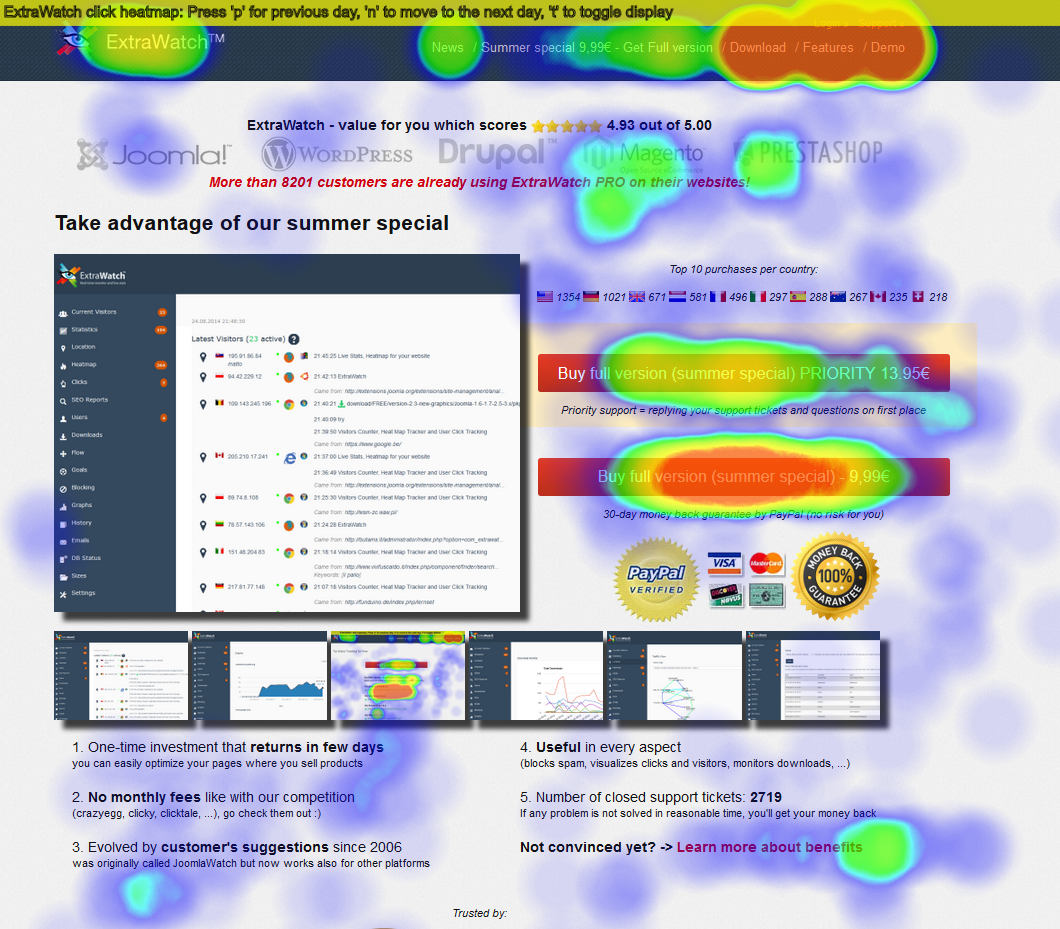5 easy steps to use Heat Map to makes your pages convert better. Click Heat Maps – Replacing Your Old Stats Counters With Something That Actually Helps
Changing the past is impossible – in fact, you cannot even change what happened two minutes back. If you really want to change the way your online business behaves with your clients, you should have real time analytics that allow you to act in time. With most online content being short lived, it becomes all the more important to have an insight into what works on your website and what doesn't. Click heat maps are designed just to do that. They help you see the total click density on each page of your website. They also help you identify the hotspots on your websites – pages and links that appeal the most to users. When you know which pages are not performing that well, you can optimize them quickly.
 Click heat map incorporated into a landing page
Click heat map incorporated into a landing page
Heat Maps – Why Does Your Website Need Them?
Heat maps are web analytics tools that are great for getting an overview of user behavior on your website and help predict future behavior too. This is especially helpful when you want to look at how your landing page is behaving. The logic behind it is simple. To have a responsive website, with a great user interface, you have to understand your users better. To do that, you have to understand how they are behaving with your website right now. Heat maps essentially act as a web traffic monitor, and help you analyze your ad placement and link optimization. If you have an e-commerce website, heat maps can actually help you minimize the abandonment of shopping cards. When you identify the areas on your website, which interest people, and then contrast it to areas which people have not liked, you can work on both to optimize your website. So in the end, your heat map is actually helping you with website visitor tracking, thus improving the functioning of your website and by that extension, of your business.
Understanding the Click Tracking Heat Map
Your click tracking heat map goes beyond the simple website traffic report. Heat maps are not a simple stats counter. They present no sampling or break downs. Instead, they offer a heat signature map, which tells you exactly where people click when they come to your website. Unlike a simple website visitor counter, which tells you how many visitors you have had, they tell you how your visitors are using your website and what interests them. With these heat maps, you are able to create customized analyses, by better understanding your visitors' clicks and movements presented visually.
So Now That You Have a Click Heat Map, What Next?
When you want to track visitors on website, you may want to understand their activity and learn how far they scroll down a page. Are they reading the content you offer? Are they finding your landing page interesting? Which are the pages that no one wants to visit or stay on? Your click heat maps help you understand your visitor activity, track conversions, visualize traffic flow, check all your search engine reports to get lists of keywords that people are using to get to your website, monitor which extensions are eating up your hosting space and remove them, see most active click spots on your website, monitor all the clicks that lead to downloads, monitor visits from different social media websites, detect the type of device used for each visit, keep an eye on your database status, and help manage your front end widgets and data counters.
Some Things to Think About
After you have made all the analyses, the next step is to take some action. Keeping this analyses with you, you can now
Remove the areas that have a very few clicks because these are not being visited anyway. Your visitors are probably not finding this information useful, and it may actually be nothing more than a distraction. Remove these elements, or replace them with something more useful and track these new elements closely. Identify clicks that are not leading your visit anywhere. With heat maps, it is easy to notice click patterns. If you notice that users are clicking at areas, which are not really links, your visitors may be ending up confused. Lead them somewhere useful. Observe all the areas that are getting a lot of attention. These areas are the part of your website, where you should put in more effort. Polish the existing content and add more information or high quality content on these pages because this will eventually help you. Observe the areas just below the ending of the content, to see if the visitors are moving somewhere else after they are done with the content. If they are not clicking anywhere else, it means they have reached a dead end, and that cannot be good for you. Take this opportunity to convert these endings into useful beginnings. Review all your clicks above the fold and those after the fold, and compare them with each other. These results are often shocking and eye opening. They will definitely help.